
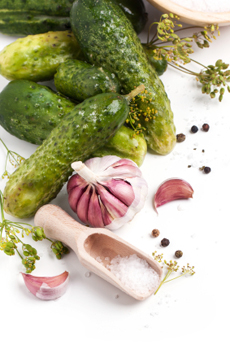
Basic ingredients for kosher-style pickles: cucumbers, salt, garlic, dill and peppercorns. Photo by Natasha Breen | IST.
|
STEPHANIE ZONIE is a contributing editor at THE NIBBLE.
|
|
November 2013
|
 |
Pickle Ingredients
Page 4: What’s In My Pickles?
This is Page 4 of a seven-page article, plus six packages of reviews of artisan pickle brands. On this page: pickle ingredients. Click on the black links below to visit other pages.
Overview
It seems as though this would be a simple matter. Pickles are going to contain cucumbers, salt, water, maybe vinegar, possibly a sweetener, and some herbs/spices, right?
Some do, but others also have flavorings (natural and artificial), preservatives, and food colors. It’s up to you whether these are acceptable in your pickles. If not, make sure you read ingredient lists before buying!
Cucumbers. All of the pickles tasted in this article were cucumber pickles, but not all use the same type of cucumber. Some sources insist that you cannot use English-style cucumbers (the type we all know from the grocery store, most often used in salads) for pickles, but there are others who say that English-style cucumbers make great refrigerator pickles. In general, pickling cucumbers are smaller, bumpier, and less round in the cross-section than the English type. You might know varieties such as County Fair, Eureka, and Miss Pickler. I found a pickling cucumber in a local Farmers Market called Silver Slicer. The color is a creamy off-white, with a pale green interior, and I’m told that variety is never bitter. There are Lemon Cucumbers, too, which have yellow exteriors and a shape much more akin to that of a lemon than a cucumber. Lemon Cucumbers are also said to lack any bitterness. |
|

Fresh cucumbers and dill arriving at the production facility. Photo courtesy Real Pickles.com. |
Choosing the correct type of cucumber is crucial in making pickles. If cucumbers are being pickled whole, they must not have waxed skins, as the pickling solution will not be able to penetrate the wax barrier. Fermented pickles cannot be made from so-called “burpless” cucumbers; those contain an enzyme that will cause the pickles to soften.
Water. Whether your pickles are lacto-fermented or contain vinegar-based brine, water will be an ingredient. Occasionally, distilled water or tap water is specified (I’ve seen “artesian well water” on a label, too), but most often the type of water is not listed.
Vinegar. Absent in lacto-fermented pickles but an ingredient in all others. Distilled white vinegar is the most widely used type, but there are pickles made with apple cider vinegar, red wine vinegar, or a combination. One pickle, the Balzy from Fresh Crunch Pickles, uses white balsamic vinegar, which gives a very different quality to the pickles.
Salt/Sodium Chloride. Salt is a natural preservative, as well as a flavoring agent. It’s present in both lacto-fermented pickles and those made with a vinegar-based brine. The level of salt in a serving of pickles varies drastically from manufacturer to manufacturer, however. At one extreme, I found Busy D’s Gourmet Pickled Products. Their Bread & Butter Chunks and Spicy Bread & Butter Chunks both contain 530 mg of sodium per one-ounce serving. Conscious Choice Foods’ The Original Beer Pickle, billed as “The Super Hot Salty Dill Pickle”, has roughly 461.5 mg of sodium per ounce. |
|
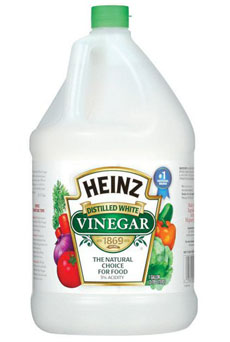
Pickles are made with distilled white vinegar—and lots of it! Photo courtesy Heinz. |
At the other end of the spectrum, there were pickles such as Oma’s Choice (95 mg of sodium per two-ounce serving); Mother’s Pickles from TabbyCat Pickling Co., which contain 50 mg of sodium in a 30 gram serving (30 grams is just over one ounce); Crazy Steve’s Cajun Cukes, with 50 mg of sodium per ounce; and the Dill Pickles from Gunnar & Jake’s Gourmet Pickles & Peppers (60 mg of sodium per ounce). If you need to watch your sodium intake, remember that not all pickles have nutrition information on their labels (this applies mostly to the small-scale companies, who are not required to list this information if they sell under a certain volume per year). Occasionally, a pickle maker will use sea salt or kosher salt instead of table salt.
|
|
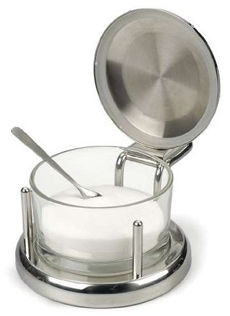
Next, add salt. Photo of salt server courtesy RSVP. |
Calcium Chloride, Lime, Alum, Grape Leaves. There are multiple types of calcium chloride, but the food-grade type is used in pickling to ensure firm, crisp pickles. Lime used to be used extensively for the same reason, but excess lime must be removed from the cucumbers for them to be safe to eat, a process that requires repeated soakings. Calcium chloride is much easier to use (you just add a small amount to each jar of pickles). Alum and grape leaves, once common in pickles, are now seen less frequently in ingredient lists, though some manufacturers still use them. One source I saw noted that alum has little effect on refrigerator pickles, though in small quantities it can improve crispness in fermented pickles. One or two grape leaves per jar of pickles are said to improve crispness, although some sources insist they may also contribute a bitter taste to pickles.
Sweeteners. Not all types of pickles contain sweeteners, but they are present in most bread & butter pickles, as well as anything in the “sweet and hot” category, candied pickles, and others. Corn syrup, high fructose corn syrup, and sugar are most frequently seen on ingredient lists, but Jammin’ Crepes Honey & Spice Jersey Pickles, obtained at the Saturday Farmers’ Market in West Windsor, New Jersey really do use honey. Brooklyn Brine sweetens some of their pickles with maple syrup.
Polysorbate 80/Tween 80. Polysorbate 80 is used in pickled foods as a solubilizer, according to Wisegeek.org This means that it assists in dissolving ingredients that might not dissolve (or might not dissolve fully) on their own. There have been questions about health effects from Polysorbate 80, but no study using human subjects has shown anything conclusive.
|
|
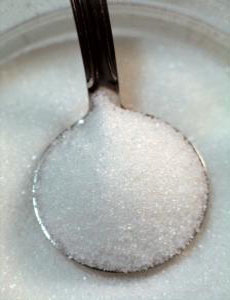
Sweet varieties like bread and butter pickles use sugar or other sweetener. Check on the label if you want to avoid HFCS. Photo courtesy SXC. |
Sodium Benzoate, Potassium Sorbate, Potassium Metabisulfite. All of these substances are synthesized preservatives, used to extend the shelf-life of foods. An article in the Los Angeles Times notes that sodium benzoate is a preservative commonly found in acidic foods (fresh-pack pickles use vinegar for acidification). Under acidic conditions, it inhibits the growth of yeasts, molds, and bacteria, thus considerably extending the shelf-life of products containing it. Use of sodium benzoate is limited by the FDA to a concentration of 0.1% by weight, though most manufacturers use less. Potassium metabisulfite also helps to preserve color.
Natural Flavor, Artificial Flavor. According to Dr. Joanne Day, a Canadian naturopath, the only difference between these two is that artificial flavors are made from individual components blended together, while natural flavors start as real foods that are processed into individual components. Both types of flavors are made in a lab. I have a few problems with both kinds of flavorings. First, manufacturers are not required to tell you what is in either type of flavoring, as it’s considered proprietary information, something that differentiates their product from countless others on the market. But I cannot reconcile that fact with my firm conviction that consumers deserve to know exactly what’s in their foods. Then too, Dr. Day asserts that these flavorings are very concentrated substances. When they’re added to foods, it’s as though the foods are “on flavor steroids.”
|
|
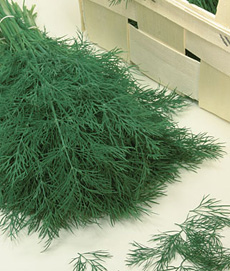
Producers can add fresh herbs, natural extracts (“natural flavor) or artificial extracts (“artificial flavor”). Which would you prefer? Photo courtesy Burpee. |
Dr. Day believes that once people (especially children) become accustomed to flavor-saturated foods, getting them to accept the more subtle tastes of foods without such intense tastes (meaning those without added flavorings) becomes difficult. Finally, flavorings are typically used as a cheap way out. If you want your pickles to taste of dill or garlic or black pepper, show consumers that you give a damn and use the real ingredients! Yes, there will always be some people who don’t care or who buy cheap pickles, either out of necessity or because they don’t know the difference. But, like wine drinkers and chocolate fanciers in the US, pickle consumers are starting to wake up and smell the herbs.
Natural and Artificial Colors. There were very few examples of “natural color” in the pickles evaluated; we can recall only two. One stated that beta carotene was used for color. That’s fine. But as with natural flavors, producers don’t have to tell you what’s in their “natural color.” Why? Why don’t consumers deserve this information? Artificial colors are a different matter. The most frequently used artificial color in pickles is tartrazine, a.k.a. Yellow #5. Tartrazine is a very bright yellow dye, frequently used in foods, drugs, and cosmetics. It’s been claimed that tartrazine does everything from lowering sperm count in men to increasing hyperactivity in susceptible children. The most balanced article I’ve found on the subject is this one. In any case, if you object to consuming this dye, as we do, check ingredient labels.
|
|
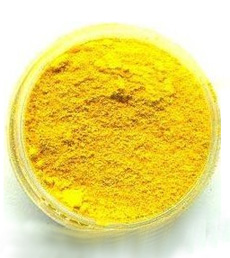
Tartrazine, a.k.a. Yellow #5 food dye. Photo courtesy Farbefirma.tradeindia.com. |
Herbs, Spices, and Members of the Allium* Family. Added to pickles in a bewildering range of colors and flavors. The mix in any given jar might include onion, garlic, red bell pepper, various chili peppers (whole or minced or in chunks or flakes), celery, caraway seeds, black peppercorns, mustard seeds in several different hues, thyme, dill seed, fresh dill, cloves, juniper berries, ginger, coriander, and/or turmeric, bay leaf, cinnamon, and I’m sure I’m leaving out a few others.
Other Flavoring Agents. These are limited only by the minds of the producers. I’ve seen whiskey, beer, hops, bourbon, actual mustard (as opposed to mustard seeds), hot cinnamon candies, and raisins as ingredients in cucumber pickles.
|
|
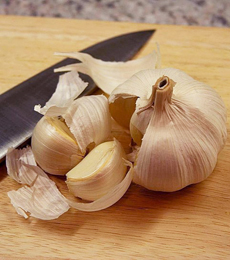
Garlic is de rigueur in many brines. It is what makes a pickle “kosher-style.” Photo courtesy Domain-Image.com. |
*The Allium family comprises chives, garlic, leeks and onions.
Continue To Page 5: How Pickles Are Made
Go To The Article Index Above

|











